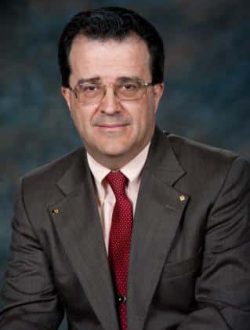Biography
Dr. Christopher P. Silva received the B.S., M.S., and Ph.D. degrees, all in electrical engineering from the University of California at Berkeley in 1982, 1985, and 1993, respectively. His graduate training was in nonlinear circuit and system theory, with work focusing on the qualitative analysis and analytical detection of chaotic dynamics, such as in second-order analog phase-locked loops.
Dr. Silva joined the Electronics Research Laboratory of the Aerospace Corporation, Los Angeles, California, in 1989 and retired as a Senior Engineering Specialist in the Communication Electronics Department, Communications and Cyber Division in 2022. He was the principal investigator on several internally funded research projects addressing nonlinear microwave CAD, private/secure communications and radar by means of chaos, nonlinear stability analysis/design of microwave circuits, and the measurement, specification, modeling and compensation of nonlinear, high data rate satellite communications channels in support of military space programs. He has given many invited talks at conferences, society meetings, universities, industry, and laboratories on the applications of nonlinear techniques to communications and signal processing, along with corresponding publications in various venues. He has also co-organized several workshops and co-instructed a regularly offered short course for the International Microwave Symposium on nonlinear related topics.
After retiring from Aerospace, he took a position as staff scientist at Tanzle, LLC addressing advanced nonlinear analog paradigms for computing/signal processing, as well as chaos-based techniques for encryption-related applications. He is currently a principal consultant at Nonlinear Circuits and Systems Engineering, LLC where he is continuing the work started at Tanzle.
Dr. Silva is an IEEE Fellow (1999), a Senior AIAA member (1999), and an AMS and SIAM member. He is also an active member of several technical committees in the IEEE MTT-S, and has served as an Associate Editor for the Transactions on Circuits and Systems (2002–2004) and Transactions on Microwave Theory and Techniques (2017–2019). More recently, Dr. Silva was an primary member of two IEEE Standards Working Groups that developed best practices for nonlinear distortion metrics and measurements. He is currently an active participant in a new IEEE Standards Working Group extending best practices for nonlinear distortion metrics to over-the-air contexts, as well as co-developing and co-presenting an online IEEE MTT-S Short Course on nonlinear stability analysis and design.
Presentations
State-of-the-Art Time-Domain Measurement and Modeling Techniques for Nonlinear Components and Systems
This presentation introduces and describes new and highly accurate time-domain measurement and modeling techniques applicable to nonlinear communications components and systems with bandwidths ranging to several GHz. An overview and comparison of time-domain versus frequency-domain measurements as they pertain to nonlinear components and systems will first be given. The development of baseband time-domain measurement techniques and system will next be covered that provides state-of-the-art measurement accuracies of time-domain waveforms critical to design verification, model construction/validation with operational modulated signals, and system troubleshooting. A survey of some common frequency-domain blackbox modeling approaches will then be described, followed by the introduction of a new systematic approach, called the poly-spectral method, that is based on the time-domain input/output measurements involving operational modulated signals. A more detailed summary of this talk is available upon request.
